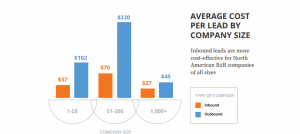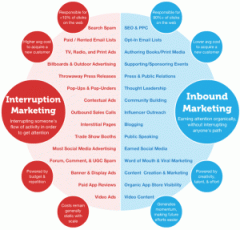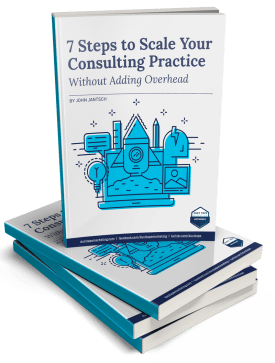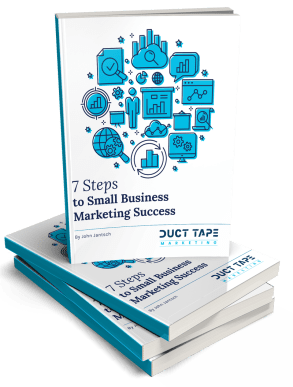It’s guest post day here at Duct Tape Marketing, and today’s guest post is from Jolynn Oblak – Enjoy!
Leveraging inbound marketing strategies can help small business grow their customer base and save money. There are two basic types of marketing – inbound and outbound. The focus of each is different and they involve different strategies and techniques.
What is Outbound Marketing?
Outbound marketing, also referred to as interruption marketing, involves getting your marketing message to the largest number of people possible through advertising, cold calling, direct mail and other aggressive techniques that interrupt people in their daily lives. Seth Godin writes extensively about interruption marketing in his book, Permission Marketing: Turning Strangers into Friends and Friends into Customers. Outbound marketing is a marketing model that requires a lot of marketing messages to be pushed out through various channels in the hope that the right message makes it to the right person. This is an expensive marketing model. So what options exist today that are cost-effective and deliver results for small businesses? In Hubspot’s 2014 state of inbound report, we find evidence to support the position that inbound marketing has the potential to deliver better results than outbound marketing.
“Half of the marketers across B2B, B2C, and nonprofit sectors ranked inbound as their primary lead source, exceeding the average (42%) of all other channels combined.”
Here are 4 key reasons that inbound marketing is the right investment for small businesses who are looking for an effective marketing method for customer acquisition.
1. The Price of Inbound vs. Outbound
Outbound marketing is a very expensive endeavor. The average cost per lead in North America is significantly less when using inbound marketing strategies. [Source: Hubspot state of inbound report, 2014].

The costs associated with outbound marketing often involves printing and mailing materials or spreading your message through television, radio or other media, making it out of reach for smaller businesses. Inbound marketing is less expensive and anyone with the right skills can do it. You create your website and blog with content that is targeted to your primary market and with a good content marketing strategy, you can attract prospects to you. You do most of the work on the front end building your site, optimizing with SEO and building a website traffic strategy. Social media is a relatively inexpensive way to find your target market compared to traditional advertising and print media. According to Hubspot, over the last 6 months, companies are relying more on Social Media, Blogging, Email Marketing and SEO for lead generation than traditional, outbound marketing [Source: Hubspot state of inbound report, 2014].
The diagram below from, Moz compares the benefits and tactics of interruption. With so many marketing messages thrust into our daily lives, it’s no wonder that consumers are ignoring these constant messages.

2. It Offers Better Two-Way Communication
One huge advantage of inbound marketing is that it’s a form of two-way communication where the customer interacts with the business in a dialog. They post on the company’s Facebook wall, comment on business blogs, or take part in contests. When they participate, they become invested and engaged. People want to be in control of the information they get and this makes them more receptive to your message. A great example of a successful inbound marketing campaign that illustrated this beautifully is the Barack Obama 2008 presidential campaign which was unprecedented in its use of social media to engage, motivate and respond to voter’s needs.
3. People Won’t Tune out your messages. Period!
Outbound marketing means putting your message in front of people whether they want to hear it or not. As a result, its techniques are often intrusive and annoying. People have begun to tune it out. Inbound marketing puts your message in front of your target market and if you employ the right content marketing strategy, they will be compelled by their own curiosity to see what you have to offer. In fact, blogging can yield 13 times increased ROI over a year [Source: Hubspot state of inbound report, 2014] and B2B marketers who use blogs generate 67% more leads per month than those who do not. [Source: Social Media B2B].
4. Inbound Marketing for Non-Marketers
Inbound marketing doesn’t feel like marketing. To market traditionally through direct mail or cold calling takes a certain amount of aggressiveness and sales skill. With inbound marketing, you provide valuable content like whitepapers, infographics and blog posts that help attract your ideal customer. It’s not “selling” in the traditional sense, so it’s more appealing to those who hate the image of the pushy salesman and may feel uncomfortable pushing their message.
With a great inbound approach, you can also recruit influencers to promote and share your content using a loot like OutreachPlus.
Clearly, small businesses can benefit in many ways by adopting an inbound marketing strategy. Think of inbound marketing as the magnet to acquire the right customer and start today with a plan for how your small business can leverage it in 2015.
If you liked this post, check out our Small Business Guide to Sales.
 Jolynn Oblak operates Oblak Marketing & Consulting, a marketing consultancy that offers digital training products that help entrepreneurs to grow their business by leveraging inbound marketing strategies. Jolynn brings more than a decade of direct & inbound marketing success to help businesses drive their products and services to a larger clientele by developing effective sales funnels and marketing plans that will turn prospects into customers and customers into lifelong fans. She shares actionable tips on business blogging, social media marketing and more via her blog. You can get in touch with Jolynn via her website at www.jolynnoblak.com
Jolynn Oblak operates Oblak Marketing & Consulting, a marketing consultancy that offers digital training products that help entrepreneurs to grow their business by leveraging inbound marketing strategies. Jolynn brings more than a decade of direct & inbound marketing success to help businesses drive their products and services to a larger clientele by developing effective sales funnels and marketing plans that will turn prospects into customers and customers into lifelong fans. She shares actionable tips on business blogging, social media marketing and more via her blog. You can get in touch with Jolynn via her website at www.jolynnoblak.com



